Search Results for: oa
Missouri Recovers from the Historic 2017 Flooding
As the waters recede from the record flooding Missouri experienced this spring, residents and businesses have been left with millions of dollars in damages, and Missourians are coming together to recover. The entire Missouri state government is committed to working with the federal and local government agencies, as well as businesses, non-profits, and individual citizens to accelerate the recovery effort. As part of that commitment, this website was created as a single source to help you easily and quickly find the information and disaster-related resources that you need.
Latest Recovery Updates:
- MARCs are open TODAY from 11 a.m. – 7 p.m. in Franklin and Oregon counties. Check the schedule for the four remaining MARCs in Gainesville (Ozark County) and House Springs (Jefferson County) on TUESDAY; Doniphan (Ripley County) on WEDNESDAY; and Arnold (Jefferson County) on THURSDAY.
- There are 10 SEMA/FEMA Disaster Assessment Teams are working with local emergency managers to survey damage in preparation for a federal disaster declaration request from Gov. Greitens. Learn about the damage assessment process here.
- Through Friday, more than 1,200 National Flood Insurance Program (NFIP) claims were being processed, representing almost $11.3 million in structural damage and almost $2.4 million in content losses in Missouri. Advance payments total over $2.5 million to meet the immediate needs of policy holders.
Missouri Recovery Media Coverage
‘What were they thinking?’ Drivers continue to die by testing flooded roads (from Associated Press)
Missouri Recovery Media Coverage
Seniors Prepared Meals for Flood Victims, Workers (from Washington emissourian.com)
Resources to help you:
How you can help:
How you can report:
Any feedback on how we can make this website better?
Click here to let us know.

Alternate Routes to St. Louis Hospitals
Alternate Routes to St. Louis-area Hospitals from the South:
Open travel routes as of 4:00 pm May 3, 2017, to St. Louis from the south. While these roads are open, heavier than normal traffic should be expected due to the flooding of other roadways.
SSM Health St. Clare Hospital, 1015 Bowles Ave., Fenton, MO 63026
Take Highway 30 North to Missouri 141. Go North on 141 to Bowles Ave. and make a right. The hospital is on Bowles just north of the intersection of MO 141.
St. Anthony’s Medical Center, 10010 Kennerly Road, St. Louis, MO 63128
Take I-55 to Exit 191 (U S 61/67 North) to I-270 West (Exit 18-C). Take I-270 West to MO 21 ( Exit 2) and go south on MO 21 to Kennerly Road. Go right on Kennerly and hospital is right there.
Barnes Jewish Hospital and Children’s Hospital in St. Louis can be reached from the South by taking I-55 to US 61/67 North (Exit 191). Take US 61/67 North to Missouri 100 (Exit 290C). Take MO 100 west to Kingshighway Blvd. and go north on Kingshighway.
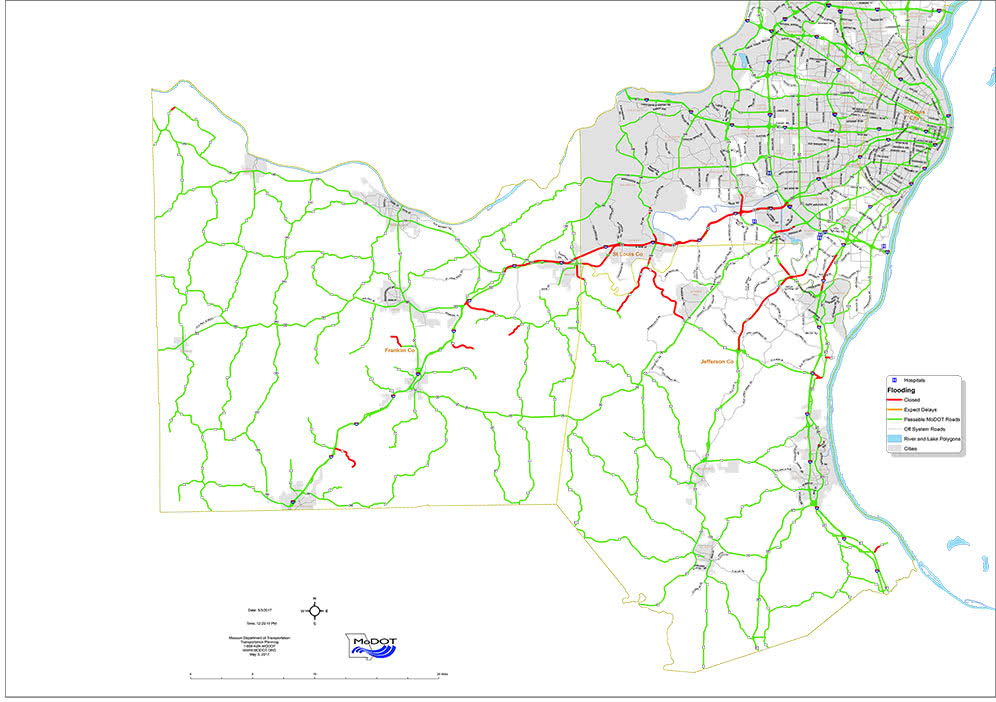

Missouri Flood Recovery
As the waters recede from the record flooding Missouri experienced this spring, residents and businesses have been left with millions of dollars in damages, and Missourians are coming together to recover. The entire Missouri state government is committed to working with the federal and local government agencies, as well as businesses, non-profits, and individual citizens to accelerate the recovery effort. As part of that commitment, this website was created as a single source to help you easily and quickly find the information and disaster-related resources that you need.
Latest Recovery Updates:
- Through Saturday, more than 750 Missouri families have been served at the first nine Multi-Agency Resource Centers (MARCs) for flood survivors.
- MARCs are open TODAY from 11 a.m. – 7 p.m. in Franklin and Oregon counties. Check the complete schedule for the six remaining MARCs in Alton (Oregon County) and Pacific (Franklin County) on MONDAY; Gainesville (Ozark County) and House Springs (Jefferson County) on TUESDAY; Doniphan (Ripley County) on WEDNESDAY; and Arnold (Jefferson County) on THURSDAY here.
- This Mother’s Day, 10 SEMA/FEMA Disaster Assessment Teams are working with local emergency managers to survey damage in preparation for a federal disaster declaration request from Gov. Greitens. Learn about the damage assessment process here.
Missouri Recovery Media Coverage
Seniors Prepared Meals for Flood Victims, Workers (from Washington emissourian.com)
Resources to help you:
How you can help:
How you can report:
Any feedback on how we can make this website better?
Click here to let us know.

Winter Weather Safety
Winters in Missouri bring the potential for dangerous snow and ice storms, which can lead to hazardous driving conditions, the loss of heat and electricity and other risks to life and safety. Extended periods of sub- freezing temperatures can also pose hazards. The best way to prepare is to plan ahead and follow local weather forecasts and news reports. Also, think about the winter hazards discussed here and select an icon to learn more.
Winter Driving Safety
When it’s snowing or a major snowstorm is in the forecast, there’s nothing more important for your safety and the safety or others than the decisions you make about driving. Avoiding a non-essential trip during a snowstorm might not only prevent a traffic crash, it can allow road crews to clear roads more quickly and keep you from becoming stranded. Before hitting the road, decide whether the trip is necessary. If you must drive when it’s snowing, here are some safety tips from the Missouri State Highway Patrol.
- Follow the local weather forecast and traffic reports. Plan travel during times when snow or icing are not in the forecast. Avoid unnecessary travel.
- Check MoDOT’s Traveler Info Map for road conditions.
- Allow extra travel time and expect delays.
- Reduce speed and increase following distance. Drive based on conditions, NOT the posted speed limit.
- Focus 100 percent on driving because you have less control of your vehicle and less visibility. Use your headlights to increase your visibility to other drivers.
- Understand that bridges and overpasses often ice over sooner than other parts of the road.
- Place an ice scraper, battery booster cables, blankets, extra coats, gloves, water, non-perishable food, flashlight, and a bag of sand or cat litter in your trunk.
- Keep you gas tank at least half full.
- Travel with a fully charged cell phone. Park your vehicle before calling if you need help. *55 on a cellular phone connects you to the closest Missouri State Highway Patrol headquarters.
- Clear your vehicle’s windows completely before driving to ensure visibility.
- Never overreact or slam on the brakes. If you begin to slide, steer in the direction of the slide to regain control of the vehicle.
- Understand 4-wheel-drive vehicles may provide extra traction to get a vehicle moving in snow, but they are not better at braking or handling turns.
- If you must travel in a snow storm, let others know about your route, destination and estimated time of arrival.
- If you become stranded in deep snow and are idling the engine to keep warm, be sure to keep the area around the tailpipe clear to avoid carbon monoxide poisoning inside the vehicle. Also, open a window slightly to let in fresh air.
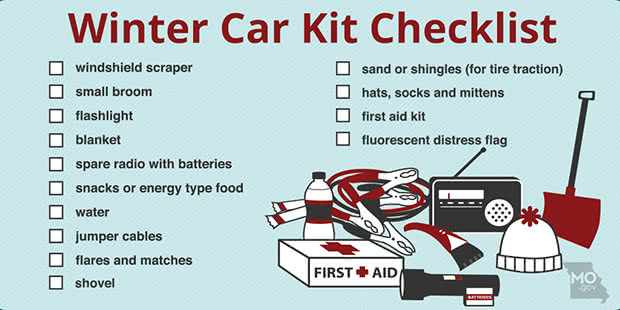
What to Do if you Get Stranded
Staying in your vehicle when stranded is often the safest choice if winter storms create visibility so poor that you can’t see or if roadways are ice covered. These steps will increase your safety when stranded:
- Tie a brightly colored cloth to the antenna as a signal to rescuers.
- Move anything you need from the trunk into the passenger area.
- Wrap your entire body, including your head, in extra clothing or blankets.
- Stay awake. You will be less vulnerable to cold-related health problems.
- Run the motor (and heater) for about 10 minutes per hour, opening one window slightly to let in air. Make sure that snow is not blocking the exhaust pipe—this will reduce the risk of carbon monoxide poisoning.
- As you sit, keep moving your arms and legs to improve your circulation and stay warmer.
- Do not eat unmelted snow because it will lower your body temperature.
- Huddle with other people for warmth.
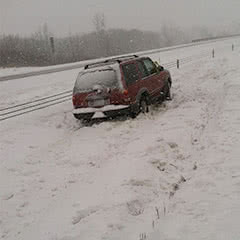
Staying Safe in Your Home during a Winter Power Outage
The loss of power and heat for extended periods during a winter storm can create potential safety risks in your home. As families prepare to use generators and alternate heat sources to keep warm, it is essential that they are aware of the risks and hazards to ensure personal safety.
If you lose heat to your home, temporarily close off less essential rooms and remain in one area of the residence. Keep warm by wearing several layers of clothing, gloves and a wool hat. Eat regularly and drink ample fluids, but avoid caffeine and alcohol.
Flashlights and battery-powered lighting should be kept in the home and ready to use during a power outage. NEVER use candles as a light source. Generators should never be operated indoors and must be well vented to prevent fumes from entering a home.
When using kerosene heaters maintain ventilation to avoid a build-up of toxic fumes. Refuel kerosene heaters outside and keep them at least three feet from flammable objects. If the pipes freeze, remove any insulation or layers of newspapers and wrap pipes in rags. Completely open all faucets and pour hot water over the pipes, starting where they were most exposed to the cold (or where the cold was most likely to penetrate).
Whenever an ice storm or some other weather event has the potential to knock out power, charge your family’s cell phones to make sure you’ll have a way to communicate and get information if power is lost.
Learn more about safety during power outages.
Avoiding Hypothermia and Frostbite
Find a Warming Shelter Near You
Extended exposure to extremely cold temperatures, particularly if there are high winds, can present serious health hazards. During bitter cold temperatures it’s important to make trips outdoors as brief as possible and to remember these safety tips.

Dress Warmly and Stay Dry
Begin by dressing correctly for the cold. Several layers of loose-fitting clothing is a good way to start. Then remember the following: a hat; a scarf or knit mask to cover your face and mouth; sleeves that are snug at the wrist; mittens, which are warmer than gloves; and a water-resistant coat and boots.
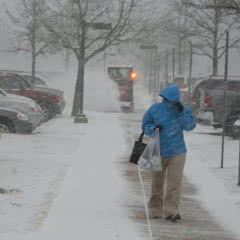
Understanding Frostbite and Hypothermia
Frostbite is an injury to the body that is caused by freezing. Frostbite causes a loss of feeling and color in affected areas. It most often affects the nose, ears, cheeks, chin, fingers, or toes. Frostbite can permanently damage the body. The risk of frostbite is increased in people with reduced blood circulation and among people who are not dressed properly for extremely cold temperatures.
Hypothermia is most likely at very cold temperatures, but it can occur even at cool temperatures (above 40°F) if a person becomes chilled from rain, sweat, or submersion in cold water.

Staying Safe When Shoveling Snow
- Check with your doctor. Because shoveling can place high stress on the heart, speak with your physician first. If you have a medical condition or do not exercise regularly, consider hiring someone to remove the snow.
- Dress appropriately. Light, layered, water-repellent clothing provides both ventilation and insulation. It is also important to wear the appropriate head coverings, as well as mittens or gloves and thick, warm socks. Avoid falls by wearing shoes or boots that have slip-resistant soles. Take a break if you feel yourself getting too hot or too cold.
- Watch for ice patches and uneven surfaces. Make sure that your hat or scarf does not block your vision. Be aware of your surroundings and alert for snow plows if you go into the street to dig out a vehicle.
- Clear snow early and often. Begin when a light covering of snow is on the ground to avoid trying to clear packed, heavy snow. Take frequent breaks and replenish fluids to prevent dehydration. If you experience chest pain, shortness of breath or other signs of a heart attack, seek emergency care
- When possible, push the snow instead of lifting it. If you must lift, take small amounts of snow, and lift it with your legs: Squat with your legs apart, knees bent and back straight. Lift by straightening your legs, without bending at the waist. Then walk to where you want to dump the snow; holding a shovelful of snow with your arms outstretched puts too much weight on your spine.
- Do not throw the snow over your shoulder or to the side. This requires a twisting motion that stresses your back.
- Use a shovel that is comfortable for your height and strength. Do not use a shovel that is too heavy or too long for you. Consider buying a shovel that is specially designed to prevent too much stooping. Space your hands on the tool grip to increase your leverage.

Winter Ice and Water Safety
What may appear to be frozen over lakes or ponds can be inviting spots for ice skaters and children who would like to explore during Missouri’s winter months. Even in bitter cold temperatures, ice conditions on bodies of water can be extremely uncertain. The only guaranteed safe skating ice is at a skating rink.
Be especially wary of ice covered with snow. Snow can hide cracks and weaknesses in open ice. Parents should educate their children about the danger of going out onto a frozen body of water, including never following a friend or a pet into these potential danger zones.


Stop Flooding Deaths in Missouri
From 2015 through 2018, 34 of Missouri’s 39 flooding deaths – 87 percent – were people who had been in vehicles. In 2015, alone, flooding killed 27 people in Missouri, more than the previous seven years combined and the highest total since 1993. Twenty-three of the 27 people who died had been in motor vehicles. Flash flooding is the leading cause of flooding deaths and historically more than half of the people killed by flooding were in motor vehicles.
Facts to Help Stop Flooding Deaths in Missouri
- Never expect barriers to block off flooded low-water crossings or bridges because floodwaters often rise so quickly authorities cannot close a road in time.
- Some motorists never see the high water until it’s too late because of poor visibility due to darkness or heavy rain.
- Be alert for high water whenever flash flooding is forecast. Slow down when visibility is limited.
- Don’t drive if you don’t have to when flash flooding is occurring in your area.
- Turn around. Don’t drown.
- Never think that because you made it across a flooded low water crossing in the past that you’ll make it the next time. Many areas saw record flooding in 2015 and others will in the future.
- Never be tempted to drive into floodwater because it appears shallow. Looks are deceiving and the roadway may not be intact. Floodwater often washes out roads or compromises their structural integrity.
- Less than a foot of moving water is enough to push a vehicle.
- Cars will float when the force of the water is greater than the force of friction. Sand and mud that come with flash flooding reduce the friction force of gravity holding the car in place
- Think about everything you could lose before trying to save a few minutes by not turning around.
- If you wind up in flood water and your vehicle stalls, leave it immediately and seek higher ground. Rapidly rising water may engulf the vehicle and sweep it away.
- On average, flash flooding kills 140 people each year in the U.S.
Flash Flood Safety Rules at Home or Work
- When a flash flood watch is issued…be alert to signs of flash flooding and be prepared to evacuate on a moment’s notice
- When a flash flood warning is issued for your area, or the moment you realize that a flash flood is imminent, act quickly to save yourself. You may only have seconds!
- Go to higher ground – climb to safety.
- Get out of areas subject to flooding. This includes dips, low spots, canyons, washes, etc.
- Avoid already flooded and high velocity flow areas. Do not attempt to cross flowing streams.
- Do not camp or park your vehicle along streams and washes, particularly during threatening weather conditions.
- Children should never play around high water, storm drains, viaducts or arroyos.
- If you come upon a flowing stream where the water is above your ankles, stop! Turn around and go another way. If water is moving swiftly, even water six inches deep can knock you off your feet.
Flash flooding fatalities statistics provided by the National Weather Service.

Missouri Time Capsule
Making your Mark on History
Thank you for submiting your nominations for items to include in the Missouri Time Capsule. The new time capsule was dedicated on Friday, July 3 at 1:00 p.m. during a ceremony on the south side of the Missouri State Capitol commemorating the 100-Year Anniversary of the Capitol Cornerstone.
A list of the items placed in the Missouri Time Capsule, including the names of those who had nominations selected, is available here.
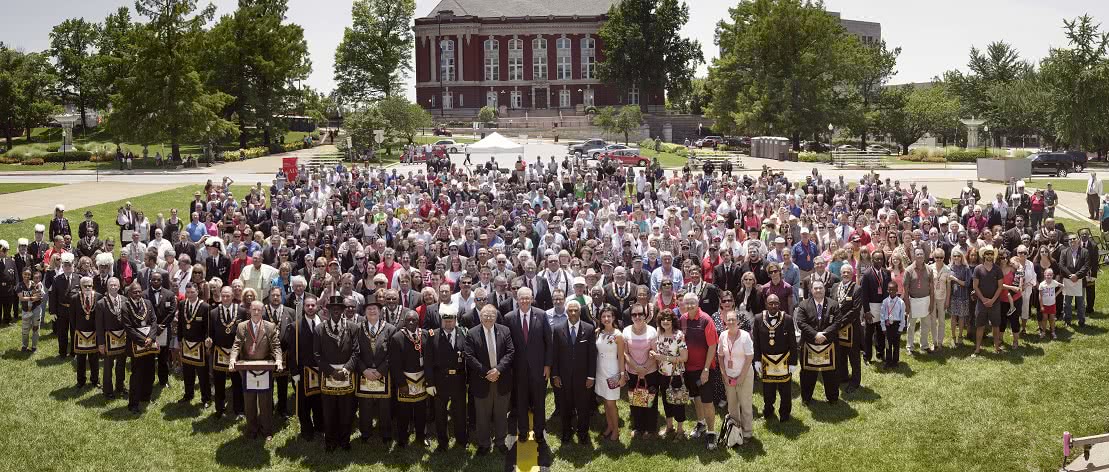
Missourians gather on July 3, 2015 to celebrate the 100-year anniversary of laying the cornerstone of the Missouri State Capitol. This photo was placed in a time capsule to be opened in 2115. (Photo credit: Jefferson City News Tribune)
Opening the 1915 Missouri Time Capsule
The 1915 Missouri Time Capsule, which was removed from the cornerstone of the Missouri State Capitol last week, was carefully opened on June 18, 2015. Video from the event is available for media use in high definition and standard definition formats. Photographs from the event are available for download as well.

Salute to Veterans
To commemorate Veterans Day, MO.gov shares stories of Missouri’s veterans in their own words. You can share your appreciation for Missouri’s veterans on social media using the hashtag #MissouriHeroes.
Meaning of Veterans Day
Richard White
Larry Creekmore
Dewey Riehn
Dave Dillon
Charlie Goodin
Goodin comes from a family whose military service dates back to the American Revolution.
Missouri National Guard
John Clark
Clark’s decorations and awards include: the Silver Star, two Legions of Merit, Distinguished Flying Cross and two Purple Hearts.
Ralph Kalberloh
Alone and wandering the German countryside, Kalberloh was taken as a P.O.W.
Message for Veterans

National “Let Freedom Ring” Day
The March on Washington, led by Dr. Martin Luther King, Jr., on Aug. 28, 1963, was a pivotal moment in our nation’s history, a time when our country stood at a crossroads for change and equality. This historic march drew more than a quarter million people who convened on the grounds of the Lincoln Memorial, capturing the attention of billions of people worldwide.
August 28, 2013, marked the 50th anniversary of Dr. King’s famous “I Have A Dream” speech. To commemorate this important date of remembrance, the state of Missouri participated in the National “Let Freedom Ring” Day with an event from 1-2 p.m. on the grounds of the Missouri State Capitol. The day’s program included music, poetry, refreshments and more.

Honoring Missourians in the Korean War
Gov. Nixon marks 60th anniversary of Korean War armistice in Washington, Mo.
On July 27, 2013, Gov. Jay Nixon joined Korean War veterans in Washington at a ceremony marking the 60th anniversary of the armistice that ended fighting in the Korean War. More than 50 veterans of the Korean War were honored at the event. After offering remarks, Gov. Nixon placed a wreath at the Korean War Memorial in Krog Park, honoring those who made the ultimate sacrifice in the war. The ceremony was presented by Chapter 324 of the Korean War Veterans Association. Read Gov. Nixon’s remarks.
Op-ed: 60 years later, we must honor our Korean War veterans
By Gov. Jay Nixon
Sixty years ago this month, the fighting ended in a war that, today, many Americans know little about. Thousands of young Missourians who fought bravely on the Korean peninsula to halt unprovoked aggression and to defend freedom came home to farms, small towns and big cities across our diverse state. Yet, returning from halfway around the world, few were greeted with fanfare or hailed as heroes… Read the complete article at governor.mo.gov.
Missouri’s Korean War Award
Missouri Korean War era veterans are eligible for the Korean War Award, awarded by the Missouri National Guard, if they served during the Korean War years. More than 17,000 Korean War Medallions have been awarded to Missouri veterans since the award was created in 2003. For more information and to apply for the Korean War Award, visit moguard.com and complete an application. The surviving spouse or oldest living survivor may also apply on behalf of an eligible veteran.
Honoring Missouri’s Korean War veterans on the 60th anniversary of armistice, July 27, 2013.
Battleship USS Missouri’s instrumental role in Korean War

USS Missouri fires her guns against enemy positions during the Korean War.
The battleship USS Missouri is best known for its role in World War II, which included the Sept. 2, 1945 signing of the Empire of Japan’s unconditional surrender in Tokyo Bay, ending the war. But the Missouri also played a key role in the Korean War. As we mark the 60th anniversary of the armistice that ended the Korean War on July 27, 1953, here’s a brief look at the Missouri’s support of U.S. forces off the coast of Korea during America’s “Forgotten War.”
The USS Missouri was ordered to Korea at top speed in June 1950, battling typhoon winds in order to offer aid and support to U.N. troops on the southeastern shore of South Korea in June 1950. Soon after, the Missouri traveled farther north to aid U.N. troops behind enemy lines at Inchon. When the North Koreans retreated, the Missouri led a task force that landed at Wonson, North Korea.
As U.N. troops pushed into North Korea, China entered the conflict, forcing U.N. forces to pull back. The USS Missouri’s 16-inch guns were able to provide enough support to the U.S. Marines to cover their sea evacuation from the Chosin Reservoir.
In late March 1952, the Missouri was relieved of its duties in the Korean Combat Zone. In October 1952, the Missouri returned to North Korea to carry out naval raids bombarding factories, transportation lines and communications facilities. The USS Missouri left Korea for the last time on March 25, 1953.
During the Missouri’s two deployments in Korea, the ship fired a total of 3,000 tons of projectiles. (Source: Missouri State Museum USS Missouri exhibit.)
USS Missouri Today
On March 31, 1992 the USS Missouri was decommissioned for the final time, and on Jan. 29, 1999 the ship was stationed as a centerpiece of the Battleship Missouri Memorial in Pearl Harbor.
Currently, the USS Missouri serves as an exhibit at the memorial, offering historical displays original to the ship and its service. For more information about the USS Missouri and the Battleship Missouri Memorial, visit ussmissouri.com.
Medal of Honor Recipients
Three Missourians received the Medal of Honor for their service in the Korean War. The Medal of Honor is the United States’ highest military honor, awarded for acts of valor above and beyond the call of duty. The medal is awarded by the President in the name of Congress to U.S. military personnel only. All three Missourians received the award posthumously.
Richard G. Wilson
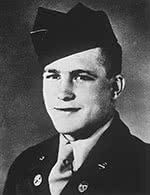
- Rank and organization: Private First Class, U.S. Army, Co. 1, Medical Company, 187th Airborne Infantry Regiment.
- Place and date: Opari, Korea, 21 October 1950.
- Entered service at: Cape Girardeau, Mo.
- G.O. No.: 64, 2 August 1951.
Citation: Pfc. Wilson distinguished himself by conspicuous gallantry and intrepidity above and beyond the call of duty in action. As medical aid man attached to Company I, he accompanied the unit during a reconnaissance in force through the hilly country near Opari. The main body of the company was passing through a narrow valley flanked on 3 sides by high hills when the enemy laid down a barrage of mortar, automatic-weapons and small-arms fire. The company suffered a large number of casualties from the intense hostile fire while fighting its way out of the ambush. Pfc. Wilson proceeded at once to move among the wounded and administered aid to them oblivious of the danger to himself, constantly exposing himself to hostile fire. The company commander ordered a withdrawal as the enemy threatened to encircle and isolate the company. As his unit withdrew Private Wilson assisted wounded men to safety and assured himself that none were left behind. After the company had pulled back he learned that a comrade previously thought dead had been seen to be moving and attempting to crawl to safety. Despite the protests of his comrades, unarmed and facing a merciless enemy, Pfc. Wilson returned to the dangerous position in search of his comrade. Two days later a patrol found him lying beside the man he returned to aid. He had been shot several times while trying to shield and administer aid to the wounded man. Pfc. Wilson’s superb personal bravery, consummate courage and willing self-sacrifice for his comrades reflect untold glory upon himself and uphold the esteemed traditions of the military service.
Billie G. Kanell
- Rank and organization: Private, U.S. Army, Company I, 35th Infantry Regiment, 25th Infantry Division.
- Place and date: Near Pyongyang, Korea, 7 September 1951.
- Entered service at: Poplar Bluff, Mo.
- G.O. No.: 57, 13 June 1952.
Citation: Pvt. Kanell, a member of Company I, distinguished himself by conspicuous gallantry and outstanding courage above and beyond the call of duty in action against the enemy. A numerically superior hostile force had launched a fanatical assault against friendly positions, supported by mortar and artillery fire, when Pvt. Kanell stood in his emplacement exposed to enemy observation and action and delivered accurate fire into the ranks of the assailants. An enemy grenade was hurled into his emplacement and Pvt. Kanell threw himself upon the grenade, absorbing the blast with his body to protect 2 of his comrades from serious injury and possible death. A few seconds later another grenade was thrown into the emplacement and, although seriously wounded by the first missile, he summoned his waning strength to roll toward the second grenade and used his body as a shield to again protect his comrades. He was mortally wounded as a result of his heroic actions. His indomitable courage, sustained fortitude against overwhelming odds, and gallant self-sacrifice reflect the highest credit upon himself, the infantry, and the U.S. Army.
Charles R. Long
- Rank and organization: Sergeant, U.S. Army, Company M, 38th Infantry Regiment, 2d Infantry Division.
- Place and date: Near Hoengsong, Korea, 12 February 1951.
- Entered service at: Kansas City, Mo.
- G.O. No.: 18, 1 February 1952.
Citation: Sgt. Long, a member of Company M, distinguished himself by conspicuous gallantry and intrepidity above and beyond the call of duty in action against an armed enemy of the United Nations. When Company M, in a defensive perimeter on Hill 300, was viciously attacked by a numerically superior hostile force at approximately 0300 hours and ordered to withdraw, Sgt. Long, a forward observer for the mortar platoon, voluntarily remained at his post to provide cover by directing mortar fire on the enemy. Maintaining radio contact with his platoon, Sgt. Long coolly directed accurate mortar fire on the advancing foe. He continued firing his carbine and throwing hand-grenades until his position was surrounded and he was mortally wounded. Sgt. Long’s inspirational, valorous action halted the onslaught, exacted a heavy toll of enemy casualties, and enabled his company to withdraw, reorganize, counterattack, and regain the hill strongpoint. His unflinching courage and noble self-sacrifice reflect the highest credit on himself and are in keeping with the honored traditions of the military service.
Source: U.S. Army
Live Stream Test
2023 State of the State Test, January 19, 3:00 pm: Vimeo Test
2022 State of the State Test, January 19, 3:00 pm: Vimeo Test
Youtube test
2021 State Of The State Address, January 27, 3:00 pm
State of the State Test, January 27, 3:00 pm
























